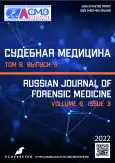Определение механизма образования черепно-мозговой травмы с учётом данных мультиспиральной компьютерной томографии: случай из экспертной практики
- Авторы: Ли Ю.Б.1,2, Вишнякова М.В.1, Клевно В.А.1
-
Учреждения:
- Московский областной научно-исследовательский клинический институт имени М.Ф. Владимирского
- Приморское краевое бюро судебно-медицинской экспертизы
- Выпуск: Том 8, № 3 (2022)
- Страницы: 85-92
- Раздел: Экспертная практика
- URL: https://journals.rcsi.science/2411-8729/article/view/122475
- DOI: https://doi.org/10.17816/fm736
- ID: 122475
Цитировать
Полный текст
Аннотация
В каждодневной практике врач судебно-медицинский эксперт решает вопрос точного определения механизма травмы, в том числе с целью правильной расстановки акцентов в ходе расследования по уголовному делу или по материалу предварительной проверки, когда устанавливается степень виновности каждого из фигурантов дела. От того, насколько существенным был «вклад» каждого из подозреваемых в совершении преступления, зависит, соответственно, и то, какой будет ответственность за содеянное. В тех же случаях, когда имеется только один подозреваемый в причинении телесных повреждений, не менее важно для следственных органов определиться, какие именно повреждения у пострадавшего лица возникли непосредственно от воздействия человека, а какие ― лишь следствие рокового стечения обстоятельств на данный момент времени. В такой ситуации чёткий ответ на вопрос о механизме травмы часто позволяет лицу, проводящему расследование, адекватно квалифицировать действия подозреваемого в соответствии с действующим Уголовным кодексом Российской Федерации. Когда речь идёт об экспертизе потерпевших, обвиняемых и других лиц (живых лиц), ситуация осложняется тем, что, по сравнению с экспертизой трупов, судебно-медицинский эксперт лишён возможности детально исследовать «нативный материал» и ограничивается только данными медицинских документов, результатами лабораторно-инструментальных методов исследования и осмотром подэкспертного, зачастую представленного следственными органами спустя длительный промежуток времени после происшествия.
Результаты мультиспиральной компьютерной томографии головного мозга, как более точного метода диагностики в сравнении со стандартной рентгенографией, вкупе с исследованием представленных материалов дела позволили в случае тяжёлой черепно-мозговой травмы последовательно определить, что комплекс повреждений, в совокупности сформировавший черепно-мозговую травму, образовался исключительно в результате падения с ударом о твёрдый тупой предмет, тем самым разграничив повреждения зон удара и противоудара.
Анализ данного экспертного случая подтверждает важность применения современных методов лучевой диагностики в судебной медицине, в частности в определении механизма черепно-мозговой травмы. Приведённый случай из экспертной практики демонстрирует важность исследования как результатов точных методов лучевой диагностики (в данном случае мультиспиральной компьютерной томографии), так и материалов дела, представленных следственными органами, для определения механизма черепно-мозговой травмы, особенно в экспертизах потерпевших, обвиняемых и других лиц.
Полный текст
Открыть статью на сайте журналаОб авторах
Юлия Брониславовна Ли
Московский областной научно-исследовательский клинический институт имени М.Ф. Владимирского; Приморское краевое бюро судебно-медицинской экспертизы
Автор, ответственный за переписку.
Email: reineerdeluft@gmail.com
ORCID iD: 0000-0001-7870-5746
заочный аспирант
Россия, Москва; ВладивостокМарина Валентиновна Вишнякова
Московский областной научно-исследовательский клинический институт имени М.Ф. Владимирского
Email: cherridra@mail.ru
ORCID iD: 0000-0003-3838-636X
SPIN-код: 1137-2991
д.м.н.
Россия, МоскваВладимир Александрович Клевно
Московский областной научно-исследовательский клинический институт имени М.Ф. Владимирского
Email: vladimir.klevno@yandex.ru
ORCID iD: 0000-0001-5693-4054
SPIN-код: 2015-6548
д.м.н., профессор
Россия, МоскваСписок литературы
- Громов А.П., Науменко В.Г. Судебно-медицинская травматология. Москва: Медицина, 1976. 368 с.
- Топография силовых напряжений в костях при травме. Атлас / под ред. проф. В.Н. Крюкова. Барнаул: Алтайское книжное издательство, 1977. 176 с.
- Крюков В.Н. Основы механо- и морфогенеза переломов. Москва: Фолиум, 1995. 232 с.
- Попов В.Л. Черепно-мозговая травма: судебно-медицинские аспекты. Ленинград: Медицина, 1988. 240 с.
- Попов В.Л. Несмертельная черепно-мозговая травма. Санкт-Петербург: Юридический центр, 2020. 112 с.
- Диагностикум механизмов и морфологии переломов при тупой травме скелета / под ред. профессора В.Н. Крюкова. Изд. 2-е, перераб. Новосибирск: Наука, 2011. 522 с.
- Клевно В.А., Кислов М.А. Морфологические признаки изломов плоских и длинных трубчатых костей в случаях ударного и компрессионного воздействия // Судебная медицина. 2015. Т. 1, № 2. С. 100–101.
- Фетисов В.А., Смиренин С.А., Хабова З.С. Особенности летальной травмы водителя и пассажира скутера при столкновении с автомобилем, двигавшемся в одном направлении // Судебно-медицинская экспертиза. 2014. Т. 57, № 5. С. 12-14.
- Ульянкин В.Е., Куприянов А.Ю., Зюбина Е.А., Мачинский П.А. Образование закрытой черепно-мозговой травмы по непрямому механизму: случай из экспертной практики // Судебная медицина. 2021. Т. 7, № 3. С. 168–171. doi: 10.17816/fm380
- Лихтерман Л.Б. Классификация черепно-мозговой травмы. Часть II. Современные принципы классификации черепно-мозговой травмы // Судебная медицина. 2015. Т. 1, № 3. С. 37–48.
- Судебно-медицинская экспертиза черепно-мозговой травмы: справочно-информационные материалы. Курск, 2014. 73 с.
- Очаговая травма головного мозга. Клинические рекомендации (утв. Министерством здравоохранения РФ). Ассоциация нейрохирургов России, 2022. 82 с.
- Клевно В.А. Проблемы судебно-медицинской экспертизы живых лиц в современном уголовном судопроизводстве // Актуальные вопросы судебно-медицинской экспертизы потерпевших, подозреваемых, обвиняемых и других лиц: тезисы докладов Всероссийской научно-практической конференции, Рязань, 15−16 марта. Москва-Рязань: РИО ГОУ ВПО «РГМУ им. акад. И.П. Павлова Росздрава»; РИО ФГУ «РЦСМЭ Росздрава», 2007. С. 3−8.
- Кильдюшов Е.М., Егорова Е.В., Кузин А.Н., Жулидов А.А. Диагностические возможности компьютерной томографии при судебно-медицинской экспертизе черепно-мозговой травмы // Судебно-медицинская экспертиза. 2018. Т. 61, № 4. С. 19–23. doi: 10.17116/sudmed201861419
Дополнительные файлы












